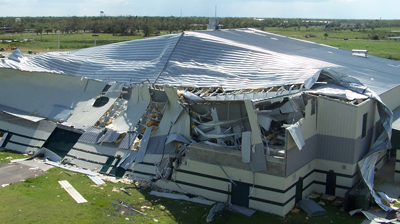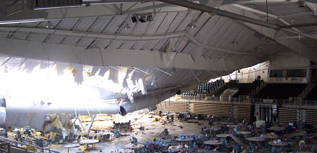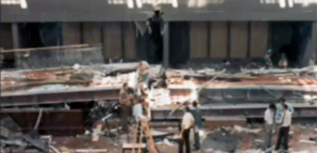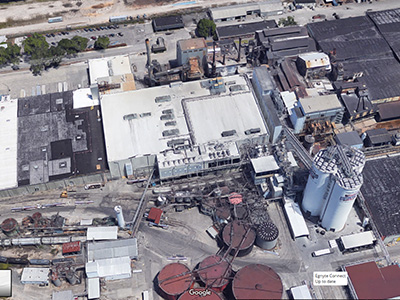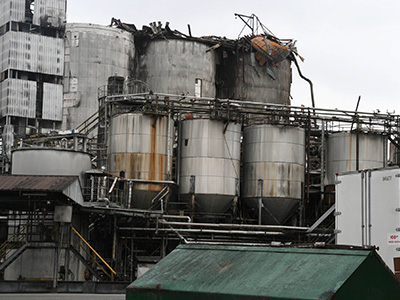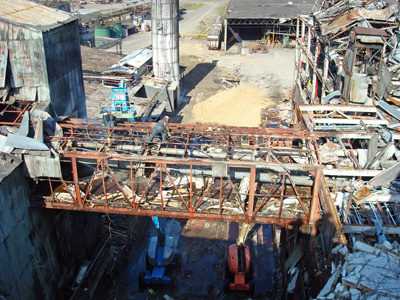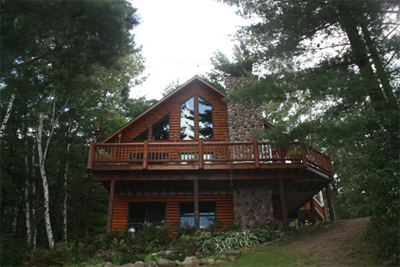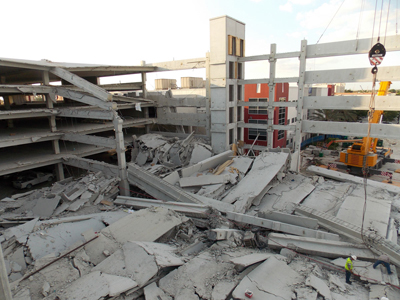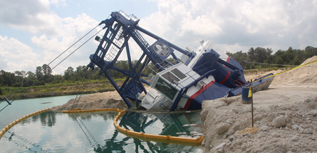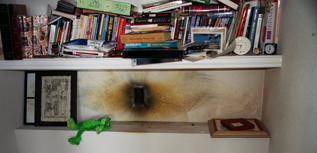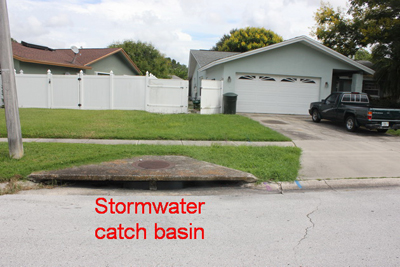A massive explosion and ensuing fire destroyed much of the Imperial Sugar processing facility. Haag engineers were asked to evaluate the scope and cost of damage, monitor the repairs, and segregate upgrades and improvements.
by John D. Stewart, P.E., Principal Engineer Emeritus
Around 7:00 am on February 7, 2008, a massive explosion occurred in the center of the Savannah Foods/Imperial Sugar facility, destroying or extensively damaging all three sugar silos and the packaging buildings that surrounded the silos. Sugar dust was believed to have been ignited by operating machinery. Many buildings outside the center of the plant also was extensively damaged. Investigations by government agencies as well as private experts concluded that the event was caused by an explosion of sugar dust followed by a fire wherein the sugar in the silos and throughout the area burned. Tragically, 14 individuals were killed in the blast and some 40 others were burned or injured.
Savannah Foods in Port Wentworth, Georgia, was founded in 1915 by Benjamin Alexander Oxnard and Richard H. Sprague when they moved their entire sugar refining operation, including more than 300 employees and their families, from St. Mary’s Parish in Louisiana to Port Wentworth. The refinery took in raw sugar and processed it into refined sugar and various other sugar products. The Savannah Sugar Refinery began melting sugar on July 7, 1917. In 1997, Imperial Sugar Corporation acquired Savannah Foods & Industries, Inc., which at the time was the second largest sugar refiner in the industry. Savannah Foods & Industries marketed its sugar under the Dixie Crystals® brand.
The Port Wentworth refinery included many large buildings, various tanks, and additional equipment for processing the sugar. Sugar was brought into the facility by ship and sent out by rail, truck, and ships. Among the facilities were three very large reinforced concrete silos located in the center of the packaging and storage area and used for storage of bulk refined sugar. These silos, constructed in 1935, were approximately 130 feet tall by 40 feet in diameter arranged in an east-west line and were capable of holding about 3 million pounds of sugar each. A large 4-story building to the north was the North Packaging Building. Another 4-story building to the south was the South Packaging Building. North and South Palletizing areas were to the west of the silos. The main refining and raw sugar storage facilities were east of the silos. Other buildings were south of the silo/packaging area.
Following the February 2008 explosion, Haag engineers were engaged by the insurers to evaluate the scope of damage and cost of repairs to the facility resulting from the event. Haag also monitored the repair work during the several year period of restoration. Haag’s role beyond evaluation of the scope of damage was to monitor and separate extensive upgrades of the rebuilt facility from needed repairs. The extensive upgrades of the facility took it from an old processing unit to a state-of-the-art processing and packaging plant.
Haag engineers were on site from shortly after the explosion until the repairs were completed and the plant restarted in late 2009. Haag was closely involved in the evaluation of the scope of damage. Knowing that the facility would be extensively modified during the restoration it was critical to prepare a detailed scope of work including estimates of repairs for facilities that would not be rebuilt in kind. Haag also was closely involved in all discussions about all changes, extensive upgrades, and reconfigurations of the facility to ensure that costs charged to the insurers of the facility were fair and represented the costs to restore an equivalent facility despite the many changes.
In summary, a massive explosion and ensuing fire destroyed the entire packaging and bulk loading facilities as well as damaging the sugar refining, electrical power and steam facilities, and storage warehouses and bulk silos. Haag engineers were called in to evaluate the complete scope of damage to the facility. Then, we developed detailed cost figures for in-kind restoration of the facility. Finally, we monitored restoration work during the two-year work period to segregate all upgrades and improvements included with the actual costs. Haag engineers were involved in evaluating damage to structural, mechanical, electrical, and process equipment. Haag prepared detailed cost estimates for all phases of the work.
John D. Stewart, P.E., is Principal Engineer Emeritus at Haag Engineering Co. and served as Haag’s President for more than 30 years (1982 – 2014). Mr. Stewart has been with Haag Engineering Co. since 1969. His engineering expertise includes evaluating and determining the scope of damage and repair options following failures, including at industrial plants, oil refineries, chemical plants. He has analyzed electrical failures, lightning damage, and electronic and computer equipment failures.
Mr. Stewart graduated from the University of Texas at Arlington with a Bachelor of Science degree in Electrical Engineering. He is a licensed professional engineer in the states of Texas and Arizona, and a member of the Institute of Electrical and Electronic Engineers (IEEE), the American Institute of Chemical Engineers (AIChE), the National Fire Protection Association (NFPA), the International Association of Arson Investigators (IAAI), the National Society of Professional Engineers (NSPE), and the Texas Society of Professional Engineers.
BELOW, A 2008 IMAGE AFTER THE EXPLOSION AND A 2019 OBLIQUE IMAGE OF THE SAME AREA (IMAGES 1 & 2). THE CENTERS OF BOTH IMAGES COVER MOST OF THE AREAS OF MAJOR DAMAGE.
